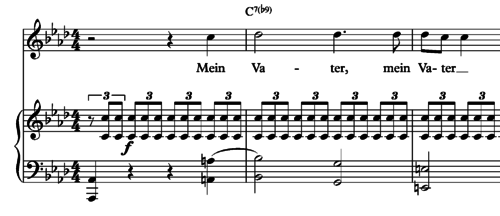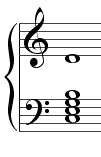Ninth chord
In music theory, a ninth chord is a chord that encompasses the interval of a ninth when arranged in close position with the root in the bass.[1]
Dominant ninth
 |
There is a difference between a major ninth chord and a dominant ninth chord. A dominant ninth is a dominant chord (and minor seventh) with a ninth. A major ninth chord (e.g., Cmaj9), as an extended chord, adds the major seventh along with the ninth to the major triad. Thus, a Cmaj9 consists of C E G B and D ![]() play . When the symbol "9" is not preceded by the word "major" or "maj" (e.g., C9), the chord is a dominant ninth. That is, the implied seventh chord is a dominant seventh, i.e. a major triad plus the minor seventh, to which the ninth is added: e.g., a C9 consists of C, E, G, B♭ and D
play . When the symbol "9" is not preceded by the word "major" or "maj" (e.g., C9), the chord is a dominant ninth. That is, the implied seventh chord is a dominant seventh, i.e. a major triad plus the minor seventh, to which the ninth is added: e.g., a C9 consists of C, E, G, B♭ and D ![]() play . C dominant ninth (C9) would usually be expected to resolve to an F major chord (the implied key, C being the dominant of F). The ninth is commonly chromatically altered by half-step either up or down to create more tension and dissonance. Fétis tuned the chord 4:5:6:7:9.[5]
play . C dominant ninth (C9) would usually be expected to resolve to an F major chord (the implied key, C being the dominant of F). The ninth is commonly chromatically altered by half-step either up or down to create more tension and dissonance. Fétis tuned the chord 4:5:6:7:9.[5]
In the common practice period, "the root, 3rd, 7th, and 9th are the most common factors present in the V9 chord," with the 5th, "typically omitted".[2] The ninth and seventh usually resolve downward to the fifth and third of I.[2]
Example of tonic dominant ninth chords include Bobby Gentry's "Ode to Billie Joe" and Wild Cherry's "Play That Funky Music".[6] James Brown's "I Got You (I Feel Good)" features a striking dominant 9th arpeggio played staccato at the end of the opening 12-bar sequence. The opening phrase of Chopin’s well-known "Minute Waltz" climaxes on a dominant 9th chord:

César Franck’s Violin Sonata in A Major opens with a dominant ninth chord (E9) in the piano part. When the violin enters in the fifth bar, its melody articulates an arpeggio of this chord.

Debussy’s "Hommage a Rameau", the second of his first Book of Images for piano solo climaxes powerfully on a dominant 9th, expressed both as a chord and as a wide-ranging arpeggio:
The starting point of Karlheinz Stockhausen’s piece for vocal sextet, Stimmung (1968) is a chord consisting of the notes B♭, F, B♭, D, A♭ and C.[7] According to Cook (1987, p.370),[8] Stimmung could, in terms of conventional tonal harmony, be viewed as ‘simply a dominant ninth chord that is subject to timbral variation. The notes the performers sing are harmonics 2, 3, 4, 5, 7, and 9 of the implied but absent fundamental—the B flat below the bass clef.’
Dominant minor ninth
| Component intervals from root | |
|---|---|
| minor ninth | |
| minor seventh | |
| perfect fifth | |
| major third | |
| root | |
| Tuning | |
| 8:10:12:14:17 | |
| Forte no. / | |
|
5-31 / |

A dominant minor ninth chord consists of a major third, perfect fifth, minor seventh, and minor ninth. In C: C E G B♭ D♭. Fétis tuned the chord 8:10:12:14:17.[5] In notation for jazz and popular music, this chord is often denoted, e.g., C7♭9. In Franz Schubert’s Song Der Erlkönig, a terrified child calls out to his father when he sees an apparition of the sinister Erl King. The dissonant voicing of the dominant minor ninth chord used here (C7♭9) is particularly effective in heightening the drama and sense of threat.

Writing about this passage, Taruskin (2010, p.149) remarks on the “unprecedented… level of dissonance at the boy’s outcries…The voice has the ninth, pitched above, and the left hand has the seventh, pitched below. The result is a virtual ‘tone cluster’…the harmonic logic of these progressions, within the rules of composition Schubert was taught, can certainly be demonstrated. That logic, however, is not what appeals so strongly to the listener’s imagination; rather it is the calculated impression (or illusion) of wild abandon.”[9]
Minor ninth
| Component intervals from root | |
|---|---|
| major ninth | |
| minor seventh | |
| perfect fifth | |
| minor third | |
| root | |
| Tuning | |
| 20:24:30:36:45 | |
| Forte no. / | |
|
5-27 / |

The minor ninth chord is played with the third and seventh both flattened, or lowered a semitone. The formula is 1, ♭3, 5, ♭7, 9. This chord is written as Cm9. This chord has a more "bluesy" sound and fits very well with the dominant ninth.
Major ninth
| Component intervals from root | |
|---|---|
| major ninth | |
| major seventh | |
| perfect fifth | |
| major third | |
| root | |
| Tuning | |
| 8:10:12:15:18 | |
| Forte no. / | |
|
5-27 / |
 Cmaj9 chord. |
 The parallel root-position bop voicings that open the choruses of Thelonious Monk's 1959 Monk's Mood feature a (C) major ninth chord.[10] |
The major ninth chord is played with the third and seventh both major. The formula is 1, 3, 5, 7, 9. This chord is written as Cmaj9.
6/9 chord

The 6/9 chord is a pentad with a major triad extended by a sixth and ninth above the root, but no seventh, thus: C6/9 is C,E,G,A,D. It is not a tense chord requiring resolution, and is considered a substitute for the tonic in jazz. Its constituent notes are those of the pentatonic scale.[12]
Heinrich Schenker, though he allowed the substitution of the dominant seventh, leading-tone, and leading tone half-diminished seventh chords, rejected the concept of a ninth chord on the basis that only that on the fifth scale degree (V9) was admitted and that inversion was not allowed of the ninth chord.[13]
Second
 Suspended chord (sus2) and added tone chord (add9) both with D (ninth=second), distinguished by the absence or presence of the third (E♭).[14] |
 Ninth (D), in red, of a C added ninth chord ( |
In music, the second factor of a chord is the note or pitch two scale degrees above the root or tonal center. When the second is the bass note, or lowest note, of the expressed chord, the chord is in third inversion ![]() Play . However, this is equivalent to a gapped eleventh chord.
Play . However, this is equivalent to a gapped eleventh chord.
Conventionally, the second is third in importance to the root, fifth, and third, being an added tone. It is generally not allowed as the root since that inversion resembles an eleventh chord on the second rather than an added tone chord on the original note. In jazz chords and theory, the second is required due to its being an added tone.
The quality of the second may be determined by the scale, or may be indicated. For example, in both a major and minor scale a diatonic second added to the tonic chord is major (C–D–E–G or C–D–E♭–G) while one added to the dominant chord is major or minor (G–A–B–D or G–A♭–B♭–D), respectively.
The second is octave equivalent to the ninth. If one could cut out the note in between the fifth and the ninth and then drop the ninth down an octave to a second, one would have a second chord (C–E–G–B♭D′ minus B♭ = C–D–E–G). The difference between sus2 and add9 is conventionally the absence or presence, respectively, of the third.
Added ninth
An added ninth chord is a major triad with an added ninth. Thus, Cadd9 consists of C, E, G and D. (The D, which might be called an added second, is two fifths up from the root.) Added ninth chords differ from other ninth chords because the seventh is never included.
See also
Sources
- ↑ Sadie, Stanley, ed. (1980). "Ninth chord", p.252, The New Grove Dictionary of Music and Musicians, vol. 13. ISBN 1-56159-174-2.
- 1 2 3 Benward & Saker (2009). Music in Theory and Practice: Volume II, p.183-84. Eighth Edition. ISBN 978-0-07-310188-0.
- ↑ Stephenson, Ken (2002). What to Listen for in Rock: A Stylistic Analysis, p.85. ISBN 978-0-300-09239-4.
- ↑ Benward & Saker (2009), p.179.
- 1 2 Fétis, François-Joseph and Arlin, Mary I. (1994). Esquisse de l'histoire de l'harmonie, p.139n9. ISBN 978-0-945193-51-7.
- ↑ Stephenson, Ken (2002). What to Listen for in Rock: A Stylistic Analysis, p.83. ISBN 978-0-300-09239-4.
- ↑ http://www.bl.uk/onlinegallery/features/breakingtherules/images/stimmung.mp3
- ↑ Cook, N., A Guide to Musical Analysis, London, J.M.Dent,
- ↑ Taruskin, R. (2010) The Oxford History of Western Music, Volume 4, Music in the Nineteenth Century, Oxford University Press.
- ↑ Walter Everett (Autumn, 2004). "A Royal Scam: The Abstruse and Ironic Bop-Rock Harmony of Steely Dan", p.208-209, Music Theory Spectrum, Vol. 26, No. 2, pp. 201-235.
- ↑ Berg, Shelly (2005). Alfred's Essentials of Jazz Theory, Book 3, p.90. ISBN 978-0-7390-3089-9.
- ↑ Jazz Lessons
- ↑ Schenker, Heinrich (1980). Harmony, p.190. ISBN 978-0-226-73734-8.
- ↑ Hawkins, Stan. "Prince- Harmonic Analysis of 'Anna Stesia'", p.329 and 334n7, Popular Music, Vol. 11, No. 3 (Oct., 1992), pp. 325-335.

.png)